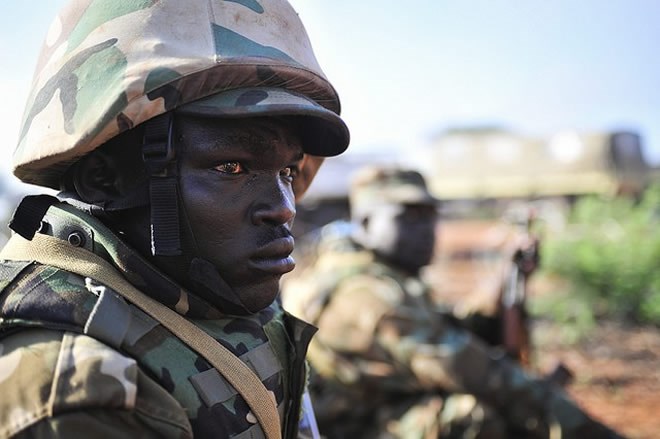
Monday, November 07, 2016

A Ugandan contingent of the AMISOM forces on the road to Baidoa. (Photo/ AU-UN IST/ Tobin Jones).
AL-SHABAAB militants seized a town northwest of Somalia’s capital Mogadishu last week, the latest urban centre to be taken by the group that has been the epicentre of Islamist terrorism in the Horn of Africa.
The town of Goofgaduud, 250km from Mogadishu, was held by government forces until al-Shabaab militants overran it on October 30. African Union (AMISOM) and Somali troops have driven the group out of major urban strongholds and ports, but they have often struggled to defend smaller, more remote areas like Goofgaduud from attacks.
“Many al-Shabaab fighters attacked us this morning and after brief fighting we left the town for tactical reasons,” Somali army Major Hussein Edin told Reuters from the nearby town of Baidoa. One Somali soldier was killed, he said, while al Shabaab’s own reports said seven Somali soldiers were killed.
The latest capture adds to a series of small victories al-Shabaab has been having on the ground. With AMISOM and Somali troops stretched thin, particularly as Ethiopian forces withdraw from central Somalia, the group has been able to steadily add to its holdings.
But there is only so much al-Shabaab can do to extend its reach while international aid is being given to the Somali military.
LOSE INTEREST
The group may have little choice but to dig in and wait, hoping that Mogadishu’s foreign partners lose interest in the conflict before the Somali national army becomes strong enough to stand on its own, say intelligence analysts Stratfor.
Somalia’s internal stability is partly linked to that of Ethiopia, its neighbour to the west with whom it has a long-running tense relationship.
Ethiopia unilaterally intervened in Somalia toward the end of 2006, to temper the Islamic Courts Union, a militant group linked to Ethiopia’s own frenemy Eritrea. ICU was a precursor to today’s al-Shabaab.
Ethiopia drew down its forces in 2009, and some of its soldiers remained behind, and most were integrated into AMISOM. Strategically speaking, however, Ethiopia’s intention is not to stabilise Somalia or ensure AMISOM’s success.
Rather, say the Stratfor analysts, Ethiopia’s interest in Somalia’s local situation is to prevent the conflict from spilling into its own ethnically Somali regions and to keep the Ogaden National Liberation Front — an Ethiopian separatist movement — from using the war-torn country as a haven.
With these objectives in mind, Ethiopia has no need to keep a tight grip on Somalia’s rural regions.
Indeed, Addis Ababa recently picked up the pace of its withdrawal after declaring a state of emergency in response to a political uprising at home. The Ethiopian government is likely hoping to keep its forces closer at hand in case its own security problems escalate.
The drawdown of Ethiopian troops has already given al-Shabaab the breathing room it needs to recapture territory. A fortnight ago, the militants overran the towns of Halgan and Tayeeglow after Ethiopian soldiers vacated them.
RESILIENCE
Al-Shabaab has shown great resilience even in the face of assaults from AMISOM, Ethiopian and Somali troops, tactically retreating when besieged, only to quietly regroup and reconsolidate. And when the group suffers battleground losses, it has resorted to asymmetrical attacks, ambushes, and violence against civilians.
AMISOM forces often end up abandoning isolated rural outposts that are not worth the effort needed to defend them from al-Shabaab’s attacks. But by leaving them to the militant group, African troops give al-Shabaab the space it requires to target other bases and acquire resources, revenue and recruits from villages close by.
A war of attrition may be the only option for the adversaries in Somalia. Few of AMISOM’s backers want to shoulder the burden of Somalia’s long term stability, several – in addition to Ethiopia – have begun to withdraw their troops.
Funding for the mission going forward is looking dicey. Since its inception, AMISOM has been fully funded by the European Union, through contributions made to AU.
But the EU is set to withdraw funding by the end of AMISOM’s UN mandate on 31 May 2017, as it seeks to re-prioritise the financing of counter-terrorism operations against the Islamic State in the Sahel region.
In June, Uganda announced it would also withdraw its troops by December 2017, because of “frustration with the Somali army and military advisers from US, UK and Turkey”, said the country’s military chief Gen. Katumba Wamala.
DIRECT HIT
But it’s not just about frustrating strategy meetings. According to media reports, the peacekeepers in Somalia have gone for months without pay. Furthermore, Uganda’s draft 2016/17 budget, anticipated that AMISOM will contribute 32% of the country’s planned defence expenditure. The EU’s funding withdrawal means a direct hit to Uganda’s domestic budget.
Uganda provides AMSIOM’s largest troop contribution, in addition to significant administrative and communication support.
Kenya, too, has threatened to withdraw its troops in Somalia. At a meeting with the UN Security Council in May, President Uhuru Kenyatta said that AMISOM was not getting the resources and equipment it needed to carry out its mandate. He said it wasn’t his government’s reponsibility to fill the funding gap.
Al-Shabaab is keenly aware of all these undercurrents, despite having suffered its own hits, including a series of high-profile drone attacks that have killed some of its leaders, and much infighting over its allegiance to other jihadist groups Al-Qaeda or the Islamic State.
The group’s leaders know that if they keep pressure on AMISOM troops while surviving any counterattacks, they may someday see the mission’s end.
Should the group outlast the forces trying to destroy it, it may have a chance of regaining control of the country.